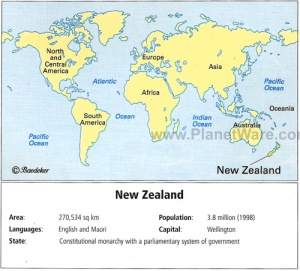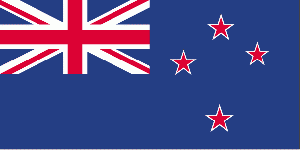New Zealand
 Location of New Zealand within the continent of Australia | |||
 Map of New Zealand | |||
 Flag Description of New Zealand: blue with the flag of the UK in the upper hoist-side quadrant with four red five-pointed stars edged in white centered in the outer half of the flag; the stars represent the Southern Cross constellation |
|||
| |||
Background of New Zealand
The Polynesian Maori reached New Zealand in about A.D. 800. In 1840, their chieftains entered into a compact with Britain, the Treaty of Waitangi, in which they ceded sovereignty to Queen Victoria while retaining territorial rights. That same year, the British began the first organized colonial settlement. A series of land wars between 1843 and 1872 ended with the defeat of the native peoples. The British colony of New Zealand became an independent dominion in 1907 and supported the UK militarily in both world wars. New Zealand's full participation in a number of defense alliances lapsed by the 1980s. In recent years, the government has sought to address longstanding Maori grievances.
History of New Zealand
Maoris were the first inhabitants of New Zealand, arriving on the islands in about 1000. Maori oral history maintains that the Maoris came to the island in seven canoes from other parts of Polynesia. In 1642, New Zealand was explored by Abel Tasman, a Dutch navigator. British captain James Cook made three voyages to the islands, beginning in 1769. Britain formally annexed the islands in 1840.
The Treaty of Waitangi (Feb. 6, 1840) between the British and several Maori tribes promised to protect Maori land if the Maoris recognized British rule. Encroachment by British settlers was relentless, however, and skirmishes between the two groups intensified.
Geography of New Zealand
People and Culture of New Zealand
Government of New Zealand
Economy of New Zealand
Energy of New Zealand
Communication of New Zealand
- Telephones - main lines in use:
- 1.88 million (2012)
- country comparison to the world: 61
- Telephones - mobile cellular:
- 4.922 million (2012)
- country comparison to the world: 113
- Telephone system:
- general assessment: excellent domestic and international systems
- domestic: combined fixed-line and mobile-cellular telephone subscribership exceeds 150 per 100 persons
- international: country code - 64; the Southern Cross submarine cable system provides links to Australia, Fiji, and the US; satellite earth stations - 8 (1 Inmarsat - Pacific Ocean, 7 other) (2011)
- Broadcast media:
state-owned Television New Zealand operates multiple TV networks and state-owned Radio New Zealand operates 3 radio networks and an external shortwave radio service to the South Pacific region; a small number of national commercial TV and radio stations and many regional commercial television and radio stations are available; cable and satellite TV systems are available (2008)
- Internet country code:
- .nz
- Internet hosts:
- 3.026 million (2012)
- country comparison to the world: 34
- Internet users:
- 3.4 million (2009)
- country comparison to the world: 62
Transportation of New Zealand
- Airports: 123 (2013)
- country comparison to the world: 48
- Airports - with paved runways:
- total: 39
- over 3,047 m: 2
- 2,438 to 3,047 m: 1
- 1,524 to 2,437 m: 12
- 914 to 1,523 m: 23
- under 914 m: 1 (2013)
- Airports - with unpaved runways:
- total: 84
- 1,524 to 2,437 m: 3
- 914 to 1,523 m: 33
- under 914 m:
- 48 (2013)
- Pipelines: condensate 331 km; gas 1,936 km; liquid petroleum gas 172 km; oil 288 km; refined products 198 km (2013)
- Railways:
- total: 4,128 km
- country comparison to the world: 42
- narrow gauge: 4,128 km 1.067-m gauge (506 km electrified) (2008)
Roadways:
- total: 94,160 km
- country comparison to the world: 50
- paved: 62,759 km (includes 199 km of expressways)
- unpaved: 32,143 km (2012)
- Merchant marine:
- total: 15
- country comparison to the world: 101
- by type: bulk carrier 3, cargo 3, chemical tanker 1, container 1, passenger/cargo 5, petroleum tanker 2
- foreign-owned: 7 (Germany 2, Hong Kong 1, South Africa 1, Switzerland 2, UK 1)
- registered in other countries: 5 (Antigua and Barbuda 2, Cook Islands 2, Samoa 1) (2010)
- Ports and terminals:
- major seaport(s): Auckland, Lyttelton, Manukau Harbor, Marsden Point, Tauranga, Wellington
Millitary of New Zealand
- Military branches:
- New Zealand Defense Force (NZDF): New Zealand Army; Royal New Zealand Navy; Royal New Zealand Air Force (Te Hokowhitu o Kahurangi, RNZAF) (2013)
- Military service age and obligation:
17 years of age for voluntary military service; soldiers cannot be deployed until the age of 18; no conscription; 3 years of secondary education required; must be a citizen of NZ, the UK, Australia, Canada, or the US, and resident of NZ for the previous 5 years (2013)
- Manpower available for military service:
- males age 16-49: 1,019,798
- females age 16-49: 1,003,429 (2010 est.)
- Manpower fit for military service:
- males age 16-49: 843,526
- females age 16-49: 828,779 (2010 est.)
- Manpower reaching militarily significant age annually:
- male: 30,846
- female: 28,825 (2010 est.)
- Military expenditures: 1.13% of GDP (2012)
- country comparison to the world: 89
- 1.12% of GDP (2011)
- 1.13% of GDP (2010)
Transnational Issues of New Zealand
- Disputes - international:
- asserts a territorial claim in Antarctica (Ross Dependency)
- Illicit drugs:
- significant consumer of amphetamines
Instituting Social Welfare of New Zealand
From the outset, the country has been in the forefront of social welfare legislation. New Zealand was the world's first country to give women the right to vote (1893). It adopted old-age pensions (1898); a national child welfare program (1907); social security for the elderly, widows, and orphans, along with family benefit payments; minimum wages; a 40-hour workweek and unemployment and health insurance (1938); and socialized medicine (1941).
New Zealand fought with the Allies in both world wars as well as in Korea. In 1999, it became part of the UN peacekeeping force sent to East Timor.
In recent years, New Zealand has introduced extremely liberal social policies. In June 2003, Parliament legalized prostitution and in Dec. 2004, same-sex unions were recognized. In 2005, Helen Clark was elected for the second time. She lost her reelection bid in 2008, when the center-right National Party, led by John Key, took 45.5% of the vote in parliamentary elections. Clark's Labour Party garnered 33.8%. Key became prime minister in November. Key's win ended nine years of governance by the Labour Party.
New Zealand Legalizes Same-Sex Marriage
On April 17, 2013, New Zealand's Parliament voted 77 to 44 in favor of same-sex marriage. Prime Minister John Key supported the legislation. The passing of the law made New Zealand the first country in the Asia-Pacific region to legalize same-sex marriage.
The new marriage equality law, which goes into effect in August 2013, also allows same-sex couples to adopt children. Their marriages are also recognized in other countries. With the passing of the legislation, New Zealand becomes the 13th country in the world where same-sex marriage is legal.
TOP 10 FACTS ABOUT NEW ZEALAND
Disclaimer
This is not the official site of this country. Most of the information in this site were taken from the U.S. Department of State, The Central Intelligence Agency, The United Nations, [1],[2], [3], [4], [5],[6], [7], [8], [9], [10], [11], [12], [13], [14],[15], [16], [17], [18], [19], [20], [21], [22], [23], [24],[25], [26], [27], [28], [29], [30],[31], [32], [33], [34], and the [35].
Other sources of information will be mentioned as they are posted.